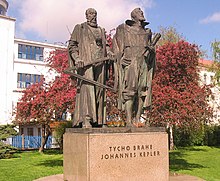Johannes Kepler
German mathematician and astronomer (1571–1630)
Johannes Kepler (27 December 1571 – 15 November 1630) was a German mathematics teacher, astronomer, optician, natural philosopher, astrologer and Lutheran theologian.
Johannes Kepler | |
|---|---|
 Portrait of Kepler, 1620 | |
| Born | December 27, 1571 |
| Died | November 15, 1630 (aged 58) Free Imperial City of Regensburg, Holy Roman Empire |
| Nationality | German |
| Alma mater | Tübinger Stift, University of Tübingen |
| Known for | Kepler's laws of planetary motion Kepler conjecture Rudolphine Tables |
| Scientific career | |
| Fields | Astronomy, astrology, mathematics and natural philosophy |
| Doctoral advisor | Michael Maestlin |
| Influences | Nicolaus Copernicus Tycho Brahe |
| Influenced | Sir Isaac Newton |
| Signature | |

He was Tycho Brahe's apprentice. Tycho Brahe looked at the way the planets moved in the sky. Johannes Kepler found a simple way to say how the planets move. Kepler also studied other things like Kepler's supernova.
How the planets move
changeA planet moves along a path called an orbit. Kepler used three laws to say what form the path has and how fast the planet moves
- Kepler's first law says that the form of the path is an ellipse, an oval or flattened circle that has two centres. The Sun is in one of the centers of the ellipse. Before Kepler, astronomers thought that planets moved in circles within circles (epicycles) according to the system of Claudius Ptolemy with Earth at the middle of the biggest circle/s.
- Kepler's second law says how fast the planet moves around the ellipse. When the planet is closer to the Sun, it moves faster. When it is farther from the Sun, it moves slower. If there is a line between the planet and the Sun, the line sweeps out an area as it follows the planet. The area it sweeps out in one day is always the same. Before Kepler, astronomers thought that planets always moved at the same speed along the circle/s.
- Kepler's third law says how fast different planets move. A planet that is farther from the Sun moves slower than a planet that is closer to the Sun. If a person multiplies the time (T) it takes for a planet to go around the Sun by itself (T2), that number is proportional to the distance (d) of a planet to the Sun multiplied by itself twice (d3).
Kepler published the first two laws in 1609, and the third in 1619.
Writings by Kepler
change- Mysterium cosmographicum (The Sacred Mystery of the Cosmos) (1596)
- Astronomia nova (New Astronomy) (1609)
- Epitome astronomiae Copernicanae (Epitome of Copernican Astronomy) (published in three parts from 1618 to 1621)
- Harmonice Mundi (Harmony of the Worlds) (1619)
- Mysterium cosmographicum (The Sacred Mystery of the Cosmos) 2nd Edition (1621)
- Tabulae Rudolphinae (Rudolphine Tables) (1627)
- Somnium (The Dream) (1634)
Related pages
changeSources
change- Caspar, Max. 1993. Kepler. transl. and ed. by C. Doris Hellman; with a new introduction and references by Owen Gingerich; bibliographic citations by Owen Gingerich and Alain Segonds. New York: Dover. ISBN 0-486-67605-6
- Gingerich, Owen. 1993. The Eye of Heaven: Ptolemy, Copernicus, Kepler. American Institute of Physics. ISBN 0-88318-863-5
- Gingerich, Owen 1973. "Kepler, Johannes". In Dictionary of Scientific Biography, Volume VII. Charles Coulston Gillispie, editor. New York: Scribner's.
Other websites
changeWikimedia Commons has media related to Johannes Kepler.